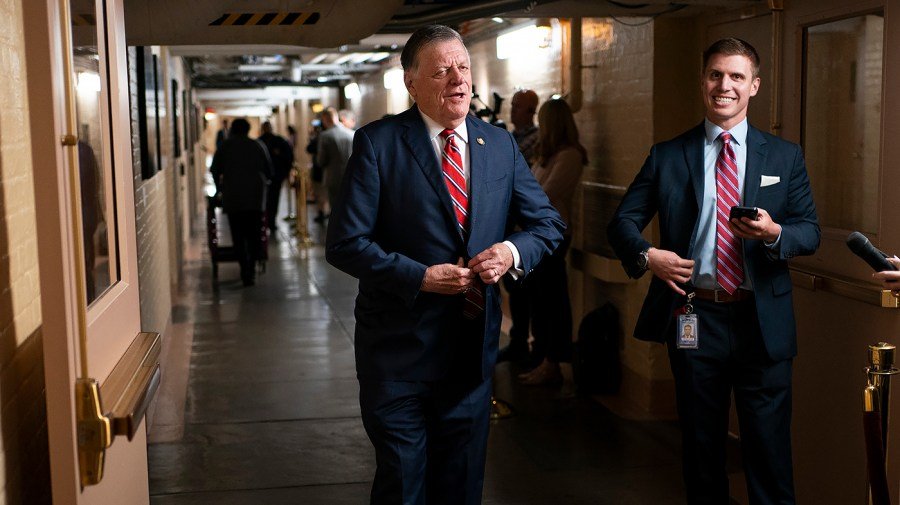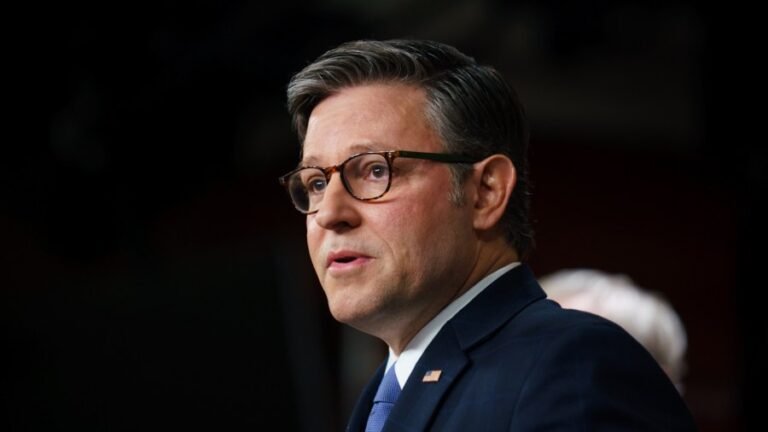
Republicans are divided as they try to chart a plan to keep the government open past the end of the month, with just 12 legislative days until funding runs out.
Top Republican appropriators are pushing for a short-term funding patch that lasts into November to buy time for Congress to strike a larger bipartisan deal to fund the government through early fall of 2026.
But some hardline conservatives, nervous about the prospect of being jammed with a massive, end-of-year omnibus and hoping to avoid Democrats negotiating spending increases, have been agitating for another full-year continuing resolution (CR).
Whichever strategy Speaker Mike Johnson (R-La.) and Senate Majority Leader John Thune (R-S.D.) pursue will affect the odds of a government shutdown because Thune will need Democratic support to push government funding legislation through the Senate. But it also has implications for Johnson’s control of his fractious, razor-thin GOP majority.
“Here’s what I think: Let’s do a one-year CR if we’re going to do that, and make it flat, so that there’s actually the cut that is associated with inflation,” said Rep. Scott Perry (R-Pa.), a former chair of the hardline House Freedom Caucus. “I’m not interested in anything that gets us right before the holidays, because we all know exactly how that’s going to go.”
Multiple Republicans have said that the White House is eyeing a stopgap funding bill into the 2026 calendar year, giving a boost to the hardliners who say that Congress should push a long-term CR.
“We know the White House wants it into next year, and if we’re going to put into next year, I say just go for it and put it into next December,” said House Freedom Caucus Chairman Andy Harris (R-Md.), who is also a senior appropriator.
Other Republican appropriators, however, want to go through the process of setting new funding levels. The government is closing in on the end of what is essentially a full-year continuing resolution, mostly operating at fiscal levels approved under the Biden administration — with leaders arguing during the last funding impasse in March that they needed more time to figure out funding levels in line with President Trump’s priorities.
House Appropriations Chair Tom Cole (R-Okla.) told reporters that he is hoping to pitch Johnson on a stopgap until the end of November. He signaled optimism that he and Senate Appropriations Chair Susan Collins (R-Maine) can negotiate a deal to approve several full-year funding bills for fiscal year 2026, which begins Oct. 1, and use a stopgap to cover the rest as they negotiate other funding levels with Democrats.
“Let’s get something moving. Let’s get a shorter-term CR and then try to keep moving and try to trigger a larger discussion on the topline,” Cole said, adding of negotiations with Democrats: “We’re not as far apart as most people seem to think we are.”
Johnson declined to weigh in on a timeline when asked about Cole’s November target, but signaled that he is open to negotiating with Democrats over a funding stopgap.
“If the government shuts down, it’ll be because congressional Democrats rejected common sense solutions to fund the government and instead caved to their far-left base,” Johnson said in a press conference Wednesday. “If Democrats are willing to work with us and think responsibly about how we can spend less than we did last year, then we are all open to that.”
And as negotiations about the funding stopgap ensue, Republicans are pressing forward on advancing regular funding bills in a show of progress on setting new spending levels.
Congress has until the end of the fiscal year on Sept. 30 to pass legislation to keep the government funded, and some Republicans are concerned that the odds of a shutdown are increasing in light of heightened partisan tensions.
House Democrats in March voted in lockstep against a measure that amounted to a full-year CR, but Senate Majority Leader Chuck Schumer (D-N.Y.) angered the Democratic base by approving the GOP-crafted measure and not forcing a government shutdown.
Harris voiced support for playing another game of shutdown chicken with Senate Democrats.
“Republicans proved that they can pass a CR, and look, if Chuck Schumer wants to vote against spending that he’s voted for twice …he can explain that to the American people.”
But there is bipartisan momentum building in both chambers for tacking some of the annual appropriations bills for fiscal 2026 on to a short-term government funding patch.
Cole told reporters on Wednesday that funding negotiators are “talking about relatively modest bills” as potential add-ons for the forthcoming stopgap plan. That includes full-year funding bills for the departments of Veterans Affairs, Agriculture and the legislative branch.
Democrats, furious about the Trump administration’s moves to claw back funding for foreign aid programs without congressional approval, also remain a wildcard in the negotiations. But some are signaling support for a bipartisan effort to push through multiple fiscal 2026 funding bills before the month’s end.
Sen. Patty Murray (Wash.), top Democrat on the Senate’s funding committee, expressed support for moving the three bills alongside a short-term funding patch.
“As part of a bipartisan, short-term CR, I support conferencing those three bills and passing them with a short-term CR for the remaining 9 bills,” Murray said at a press conference on Wednesday. “And I hope that we can continue to make progress on our Senate-passed bills so they will be ready at the end of the month.”
In a statement to The Hill on Wednesday, a White House official said the administration is “working with congressional leaders on continuing to fund the government responsibly.”
“A CR in September is increasing in likelihood given the amount of time on the congressional calendar before the expiration of the current funding bill, and conversations continue about its length,” the statement said. “Democratic threats to shut the government down over foreign aid are not in the best interest of the American people or an orderly funding process.”
But Johnson is also facing pressure from the GOP conference’s right flank for a longer-term stopgap.
Freedom Caucus member Rep. Keith Self (R-Texas) said he’d like to see another full-year continuing resolution, with maybe “an anomaly or two” to adjust spending in key priority areas like defense spending.
Rep. Eric Burlison (R-Mo.), another Freedom Caucus member, said that he would “probably not” vote for a short-term stopgap — and his support for a longer-term continuing resolution would hinge on what kind of “anomalies” are in the legislation.
“If they’re going to put a bunch of earmarks in there, there’s no way that I’m going to support that,” Burlison said.
Yet those funding boosts for projects and initiatives in members’ districts, renamed from earmarks to community funding projects, are a priority for other Republicans in a continuing resolution.
Many Republicans have already been frustrated by the lack of funding for projects back home under the current stopgap the government has been operating under since March


